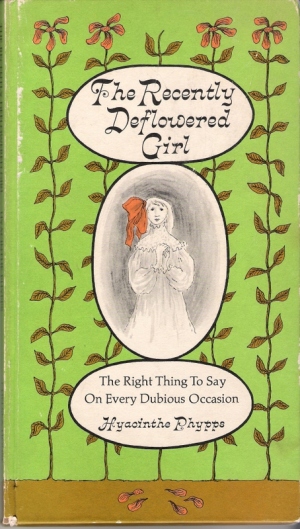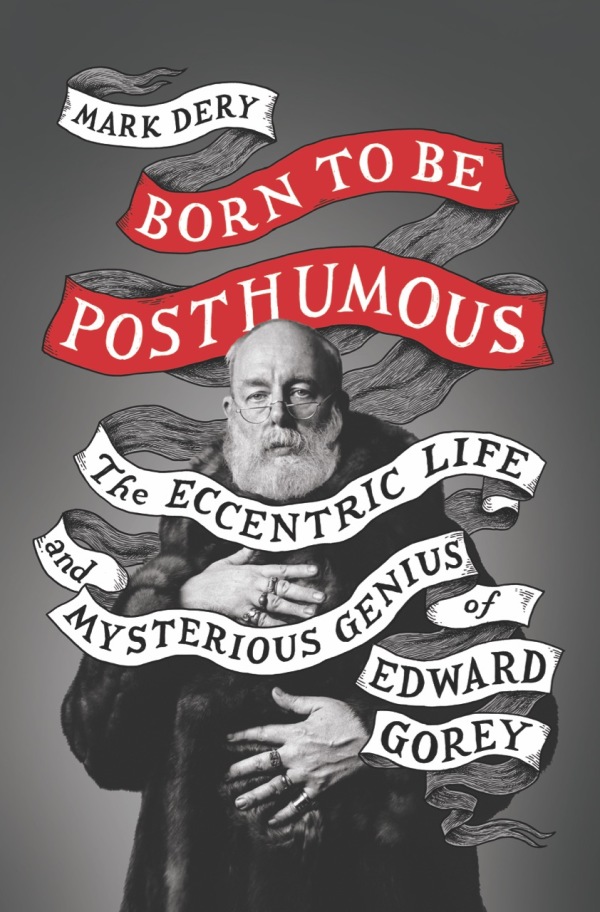THE ATLANTIC: When the war was over, Gorey went to Harvard, where he set about the business of—as Dery puts it—“becoming Gorey.” His assistant dean found him to be a “queer looking egg.” But his best buddy was the poet Frank O’Hara, so who cares? There began the long coats, the many rings, the weary supremacy. He had crushes on other men. No sex, though, as far as Dery can ascertain, and no long-term companionship. Sedulous bachelorhood became the MO. Morrissey again: The hills are alive with celibate cries. Gorey moved to Manhattan in 1953 and churned out book covers for Doubleday’s mass-market imprint Anchor. This was also the year he published the first of his small books, The Unstrung Harp, about a novelist named Mr. Earbrass. Gorey would never again use so much prose in a book, but the prose was good and, more important, it was Gorey: “Mr. Earbrass stands on the terrace at twilight. It is bleak; it is cold; and the virtue has gone out of everything.”
His poetry, meanwhile, was poetry. A fugitive and lurid gleam / Obliquely gilds the gliding stream. So run the lines beneath a panel in his 1969 book The Iron Tonic. Parodic? Iron-tonic ironic? Yes and no. These are lovely, Tennysonian lines, but with a slight chemical distortion, as if Tennyson had forgotten to take his lithium. In the illustration, a tiny-headed man in a huge fur coat stands (transfixed? lost? dreaming?) in a snowy landscape, on the bank of a dark stream. Rods of light come poking through the low clouds, and the gliding stream is indeed obliquely gilded. It’s Gorey all the way down: a heavy-hanging antique atmosphere retro-injected with modernity, with anomie, with freaky deadpan emptiness.
Gorey entered the American cultural mainstream quite suddenly on the evening of February 5, 1980, when WGBH, the Boston PBS affiliate, debuted its Mystery anthology of British crime dramas. Mystery featured title sequences tracked by tango music and worked up by the animator Derek Lamb and his team from motifs in Gorey’s books: a pen-and-ink montage of rain, tombstones, flitting aristocrats, a disconsolately struck croquet ball being crushed by falling masonry, a woman’s cry, wilting and droopily orgasmic. The series was a hit, and Gorey—in his creeping, ivylike way—went nationwide.
His influence today, the seep of his sensibility, is pervasive: Dery efficiently lays out the debt owed him by the graphic-novel author Neil Gaiman, the cartoonist Alison Bechdel, the filmmaker Tim Burton, and any other fantasist who loiters in the dark gardens of childhood. “When I was first writing A Series of Unfortunate Events,” remembers Daniel Handler, the author of the Lemony Snicket series, “I was wandering around everywhere saying, ‘I am a complete rip-off of Edward Gorey,’ and everyone said, ‘Who’s that?’ Now everyone says, ‘That’s right; you are a complete rip-off of Edward Gorey!’?” You can hear Gorey’s feline phrasing in the voice-overs of Wes Anderson movies. Or you can just look at a dusty chandelier, or someone in jodhpurs, or a particularly knotty, obscurely communicative tree, and say: Yup … Gorey-esque. MORE
PREVIOUSLY: Edward Gorey was a lot of things — illustrator, author, designer, screenwriter, animal lover, pop culture junkie, antiquarian aesthete — but above all else, he was, for better or worse, the post-modern godfather of goth, a lineage that stretches back to Edgar Allan Poe, the pre-modern godfather of goth. Absent Gorey’s meticulously cross-hatched pen-and-ink chiaroscuros — typically exquisitely gloomy drawing room  interiors and the forlorn coal-eyed waifs that haunt them — there would be no Tim Burton. Though he illustrated and authored countless books from the 1950s through the 1990s, and continued re-packaging and publishing his work up until his death in 2000, Gorey’s touchstone work will forever be The Gashlycrumb Tinies, a splendidly macabre illustrated alphabet book wherein 26 children, each one named after a letter of the alphabet, die in ways both devious and dastardly. Late last year, Bloomsbury re-published The Recently Deflowered Girl, a faux -advice book for young women navigating the newly opened world of sexuality. Originally published in 1965 and long since forgotten, the book features Gorey’s renderings of the recently de-virginized girls, the unlikely suitors, and the outlandish settings where the dirty deed got done. The accompanying nudge-nudge-wink-wink text by Hyacinthe Phypps (aka Mel Juffe ) counsels the freshly deflowered ladies on how best to extricate themselves from these unseemly assignations with whatever is left of their dignity and pride. Back when it was originally published, The Recently Deflowered Girl was an amusing harbinger of the then-blossoming sexual revolution. Today, in age of sexting and Viagra ads on prime time, it is amusing for a whole other set of reasons — reasons that we asked Bloomsbury editor Margaret Maloney to explain. It was Maloney who helped shepherd the book from the outer reaches of the Internet, where it was first re-discovered, to a Barnes & Noble near you. MORE
interiors and the forlorn coal-eyed waifs that haunt them — there would be no Tim Burton. Though he illustrated and authored countless books from the 1950s through the 1990s, and continued re-packaging and publishing his work up until his death in 2000, Gorey’s touchstone work will forever be The Gashlycrumb Tinies, a splendidly macabre illustrated alphabet book wherein 26 children, each one named after a letter of the alphabet, die in ways both devious and dastardly. Late last year, Bloomsbury re-published The Recently Deflowered Girl, a faux -advice book for young women navigating the newly opened world of sexuality. Originally published in 1965 and long since forgotten, the book features Gorey’s renderings of the recently de-virginized girls, the unlikely suitors, and the outlandish settings where the dirty deed got done. The accompanying nudge-nudge-wink-wink text by Hyacinthe Phypps (aka Mel Juffe ) counsels the freshly deflowered ladies on how best to extricate themselves from these unseemly assignations with whatever is left of their dignity and pride. Back when it was originally published, The Recently Deflowered Girl was an amusing harbinger of the then-blossoming sexual revolution. Today, in age of sexting and Viagra ads on prime time, it is amusing for a whole other set of reasons — reasons that we asked Bloomsbury editor Margaret Maloney to explain. It was Maloney who helped shepherd the book from the outer reaches of the Internet, where it was first re-discovered, to a Barnes & Noble near you. MORE

